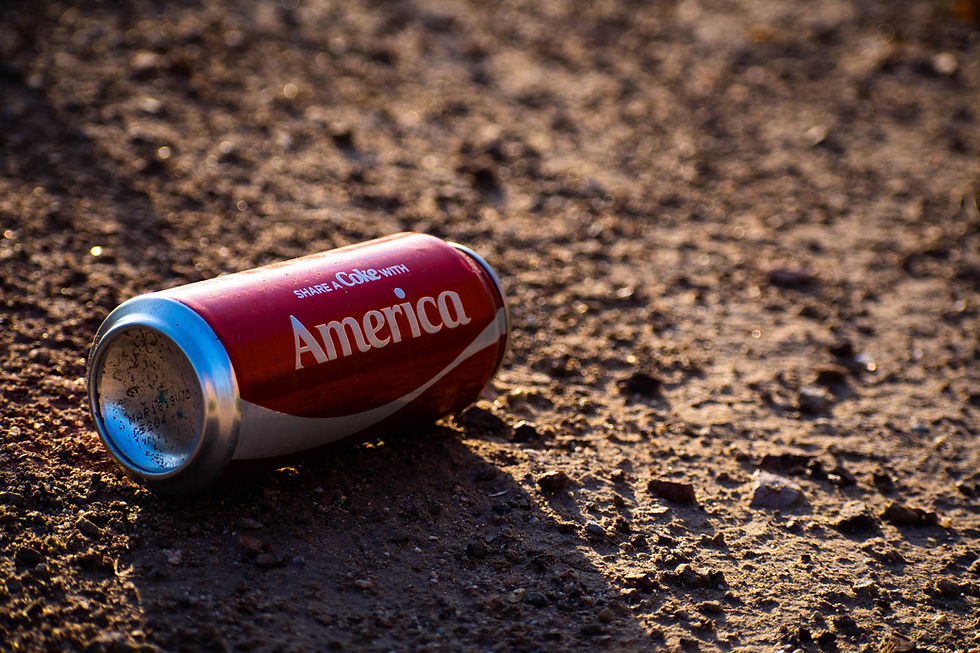Coca-Cola vs. Pepsi: A Century-Long Battle of Brands
- Marcelo Serafim
- Aug 7
- 4 min read
Introduction
The rivalry between Coca-Cola and Pepsi is one of the most iconic in business history. Spanning more than a century, these two soft drink giants have competed fiercely for global market share, brand dominance, and customer loyalty. The so-called “Cola Wars” have shaped the beverage industry and offer rich lessons in marketing, innovation, and competitive strategy.

Origins of the Brands
Coca-Cola was invented in 1886 by pharmacist John Stith Pemberton in Atlanta, Georgia. Pepsi followed in 1893, initially named "Brad’s Drink," created by Caleb Bradham. Both began as medicinal tonics but soon evolved into mass-consumed carbonated beverages. From the start, the two brands carved out distinct identities, with Coca-Cola embracing tradition and heritage, while Pepsi aligned with innovation and youth.
The Cola Wars
The term “Cola Wars” gained prominence during the 1980s, when Pepsi launched aggressive advertising campaigns targeting Coca-Cola’s market leadership. One of the most famous was the “Pepsi Challenge,” where blind taste tests claimed consumers preferred Pepsi over Coke. In response, Coca-Cola introduced the infamous “New Coke” formula in 1985, which faced massive public backlash and was quickly reverted.
Marketing Strategies

Coca-Cola has consistently emphasized emotional branding, using slogans like “Open Happiness” and memorable Christmas campaigns featuring Santa Claus. Pepsi, on the other hand, often associates itself with pop culture, music, and youth icons—Michael Jackson, Britney Spears, and Beyoncé have all featured in Pepsi ads. These contrasting strategies have helped both companies maintain distinct brand personalities.
Product Diversification
Beyond cola, both companies have diversified extensively. Coca-Cola owns brands like Sprite, Fanta, and Minute Maid, while PepsiCo controls Gatorade, Tropicana, and Lay’s. PepsiCo’s strength lies in its dual focus on beverages and snacks, giving it a broader portfolio. Meanwhile, Coca-Cola focuses almost entirely on beverages but holds a dominant position in global distribution networks.
Global Expansion
Both companies are global titans, but Coca-Cola leads in international reach. In many countries, Coca-Cola has become synonymous with cola itself. PepsiCo has had mixed success abroad, partly due to regional preferences and distribution challenges. However, Pepsi has found strongholds in markets like India and Mexico, where local partnerships helped boost market share.
Financial Performance
While Coca-Cola and PepsiCo generate billions annually, their financial models differ. Coca-Cola primarily focuses on beverage concentrate sales to bottlers, while PepsiCo generates significant revenue from its snack divisions. In recent years, PepsiCo’s diversified model has proven resilient, particularly during periods when consumers shift away from sugary drinks.

Health & Sustainability Challenges
As health awareness grows, both companies have faced criticism over sugar content and environmental impact. In response, Coca-Cola and PepsiCo have invested in low-calorie drinks, bottled water, and sustainable packaging. However, balancing health trends with brand identity remains a complex challenge.
Recent Trends
The digital age has brought new battlegrounds—social media campaigns, influencer partnerships, and e-commerce have become vital. Coca-Cola recently launched its “Coca-Cola Creations” line, exploring experimental flavors and digital experiences. Pepsi continues to focus on digital storytelling and youth engagement through music and entertainment.
Conclusion
The Coca-Cola vs. Pepsi rivalry is far more than a business competition—it’s a cultural phenomenon. Each company continues to innovate and evolve in response to changing consumer behavior, economic conditions, and global trends. Whether you’re a Coke or a Pepsi fan, there's no denying the business brilliance behind both brands.
❓ Five Discussion Questions
Why do you think Coca-Cola has a stronger global presence than Pepsi?
How did the "Pepsi Challenge" influence Coca-Cola’s strategy in the 1980s?
Which brand do you think has more effective advertising, and why?
How do diversification strategies affect long-term brand success?
Should soft drink companies be more responsible in promoting healthier products?
📘 Vocabulary Section
Word | Meaning |
Iconic | Widely recognized and regarded as representative or influential |
Backlash | A strong negative reaction to a decision or action |
Diversification | The process of expanding into new products or markets |
Synonymous | Closely associated with or indistinguishable from |
Heritage | Traditions or qualities passed down through generations |
Titans | Extremely powerful or influential people or companies |
Resilient | Able to withstand or recover quickly from difficulties |
Phenomenon | A remarkable or unusual event, trend, or occurrence |
Carbonated | Containing carbon dioxide gas, making it fizzy |
Reverted | Returned to a previous condition or state |
🔄 Phrasal Verb: "Take on"
Meaning: To compete against or challenge someone Examples:
Pepsi took on Coca-Cola with its “Pepsi Challenge” campaign.
The smaller brand decided to take on the market leader in a bold move.
🇺🇸 American Idiom: "Level the playing field"
Meaning: To create equal conditions for all participants Example: Pepsi’s aggressive advertising helped level the playing field against Coca-Cola’s dominance.
📝 English Grammar Tip: Past Perfect vs. Simple Past
When referring to two events in the past, use past perfect for the earlier one.
Example from the text:
Coca-Cola introduced the infamous “New Coke” formula after Pepsi had launched the “Pepsi Challenge.”
✅ Use had + past participle for the first past action:
He had already left when she arrived.
They had finished the ad campaign before launching the new product.
Listening
📚 Homework Proposal
Task: Write a comparative analysis (200–250 words) between Coca-Cola and Pepsi. Focus on brand identity, marketing strategy, and global presence. Use at least two phrasal verbs, one idiom, and three words from the vocabulary section.
Optional Extension:Create a marketing pitch for a new flavor for either brand. Include a slogan and describe the target audience.



Comments